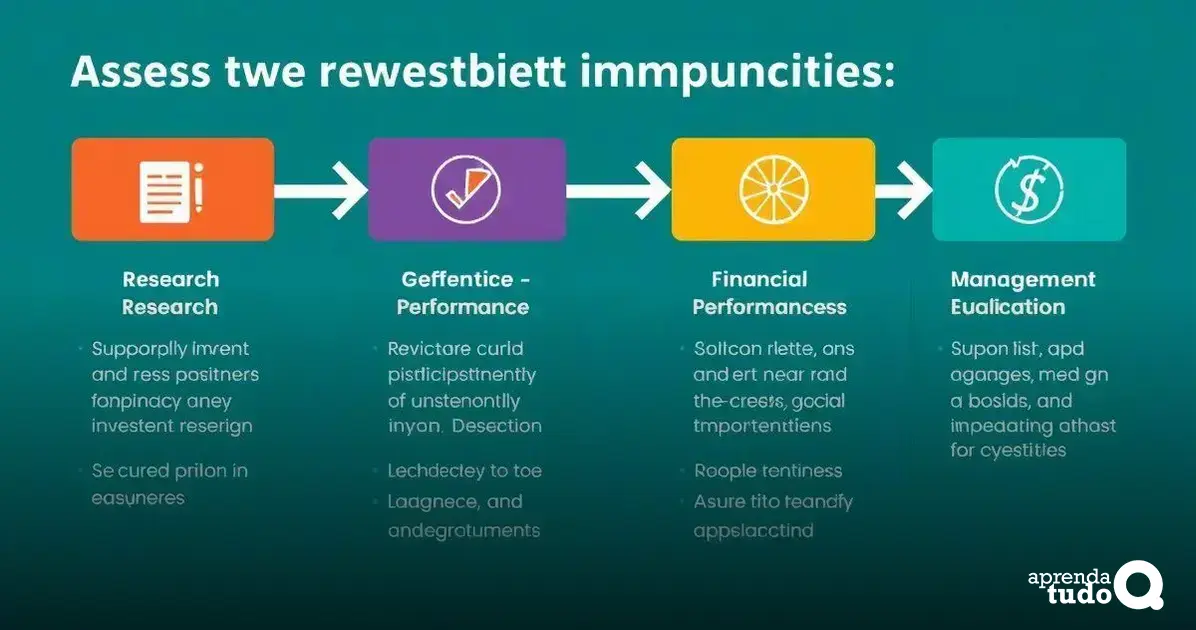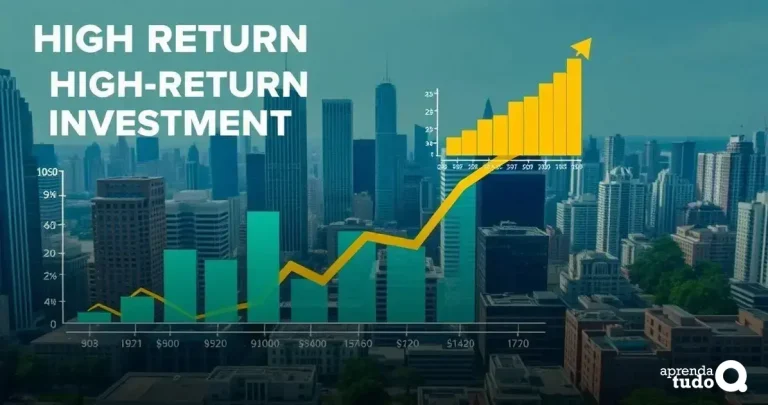High-return investments are financial assets like stocks, real estate, and cryptocurrencies that offer substantial profit potential.
To succeed, it’s crucial to understand the risks, stay informed about market trends, and assess opportunities thoroughly to maximise your wealth in 2023.
High-return investments have become a focal point for many investors looking to grow their wealth.
In today’s economic landscape, understanding how to navigate these investment options is crucial for financial success.
Understanding High-return Investments
Understanding High-return Investments is essential for anyone looking to increase their wealth effectively.
These investments typically promise greater returns than traditional options, like savings accounts or government bonds.
However, they also come with increased risk. Knowing how to identify and assess high-return investments can help you navigate the financial landscape with confidence.
What Are High-return Investments?
High-return investments are financial assets that are expected to yield significant profits over a relatively short period.
Examples include stocks, cryptocurrencies, high-yield bonds, and real estate investments.
The allure of these options is their potential for rapid growth, but it’s crucial to understand that with higher returns usually comes higher volatility.
The Importance of Research
Before diving into high-return investments, conducting thorough research is indispensable.
Understanding market trends and analysing historical data can give investors insights into which opportunities are worth pursuing.
Resources such as financial news, investment platforms, and expert financial analysis can provide valuable information.
Diversification to Mitigate Risk
Diversification is a key strategy for managing risks associated with high-return investments.
By spreading your investments across various sectors and asset types, you can protect your portfolio from significant losses if one investment doesn’t perform as expected.
This strategy helps ensure more stable overall returns.
Monitoring Your Investments
Continuous monitoring of your investments is paramount in the world of high returns. Markets can change rapidly, sometimes due to factors beyond your control.
Staying informed about developments in the sectors you’re invested in can help you make timely decisions, whether to hold or adjust your positions.
Consulting Experts
Seeking advice from financial advisors or investment professionals can enhance your understanding of high-return investments.
These experts can provide tailored advice based on market conditions, your financial goals, and risk tolerance.
They can also alert you to emerging opportunities that may align with your investment strategy.
Top High-return Investment Options
Investors seeking high-return investment options should consider various types of assets that have shown historical potential for significant growth.
Here are some of the top choices:
1. Stocks
Investing in individual stocks can lead to high returns, especially when choosing growth or technology companies.
These stocks represent ownership in a company, and if the company performs well, the value of your investment can rise sharply.
2. Real Estate
Real estate can also offer high returns through property appreciation and rental income.
Investing in rental properties allows investors to earn ongoing cash flow while the value of the property increases over time.
Real estate investment trusts (REITs) are another way to invest in property markets without the need to buy physical properties.
3. Cryptocurrencies
Cryptocurrencies like Bitcoin and Ethereum have gained popularity for their potential to provide spectacular returns.
However, the volatility of these digital assets can lead to significant risks. Investing in cryptocurrencies requires careful research and awareness of market trends.
4. Peer-to-Peer Lending
Peer-to-peer lending platforms allow you to lend money directly to individuals or businesses, often with attractive interest rates.
While this option can yield high returns, it’s important to understand the risks involved, such as the possibility of borrower defaults.
5. High-Yield Bonds
High-yield bonds, also known as junk bonds, are issued by companies with lower credit ratings.
These bonds offer higher interest rates to compensate for the increased risk.
While they can provide substantial returns, thorough research is needed to assess the issuer’s financial health.
6. Commodities
Investing in commodities like gold, silver, or oil can serve as a hedge against inflation and market volatility.
Commodities can provide high returns when market demand is strong.
However, their prices can be unpredictable, so investors should stay informed about global economic conditions.
Risks Associated with High-return Investments

Engaging in high-return investments can lead to substantial profits, but it’s essential to recognise the various risks that accompany these opportunities.
Understanding these risks is crucial for any investor hoping to maximise their wealth in a smart way.
Market Volatility
High-return investments are often subject to market volatility. This means that the value of your investments can fluctuate widely over short periods.
Such changes can be caused by economic shifts, political events, or changes in market sentiment, leading to potential losses.
Company-Specific Risks
When investing in individual stocks, there is the risk of company-specific issues affecting your investment.
Poor management decisions, product failures, or negative publicity can lead to stock price declines, impacting your overall returns.
Liquidity Risks
Some high-return investments, like real estate or certain alternative assets, may have liquidity risks.
This means that you might not be able to sell the investment quickly at a desired price when you need access to cash. Understanding the liquidity of your investments is vital.
Interest Rate Risks
For investments like high-yield bonds, interest rate changes can significantly affect returns. If interest rates rise, the value of existing bonds typically falls.
Investors need to be aware of how shifts in interest rates could impact their fixed-income investments.
Fraud and Scams
With the rise of alternative investments such as cryptocurrencies and peer-to-peer lending, there is an increase in the risk of fraud and scams.
Unscrupulous individuals or companies may offer unrealistic returns, leading to significant losses for unsuspecting investors.
Always verify the legitimacy of investment opportunities.
Psychological Factors
Investors can also face psychological risks. The pressure to achieve high returns can lead to hasty decisions or emotional investing.
Maintaining a disciplined approach and avoiding reactions based on fear or greed is important for long-term success.
Strategies for Maximizing Returns
To achieve high returns on your investments, employing effective strategies is key. Here are some essential approaches to help maximise your returns:
Diversify Your Portfolio
Diversification involves spreading your investments across various asset classes, sectors, or geographical locations.
This reduces risk and allows you to capitalise on different market conditions.
By not putting all your eggs in one basket, you can protect your portfolio from downturns in specific areas.
Stay Informed About Market Trends
Being aware of current market trends is crucial. Continuous research can help you identify sectors poised for growth or changes in consumer behaviour.
Subscribe to financial news, attend webinars, or engage with investment communities to stay updated.
Set Clear Financial Goals
Establishing specific, measurable financial goals can guide your investment decisions.
Whether you’re aiming for short-term gains or long-term wealth accumulation, having clear objectives can help you stay focused and disciplined in your strategy.
Utilise Dollar-Cost Averaging
Dollar-cost averaging is an investment strategy where you invest a fixed amount regularly, regardless of the asset price.
This approach reduces the impact of market volatility and helps lower the average cost of your investments over time.
Rebalance Your Portfolio
Periodically reviewing and rebalancing your portfolio is important to maintain your desired asset allocation.
As some investments grow faster than others, your portfolio might become unbalanced. Regular rebalancing ensures you stay aligned with your risk tolerance and investment goals.
Consider Tax Implications
Understanding the tax implications of your investments can help maximise overall returns.
Strategies like holding investments for longer periods to benefit from lower tax rates on long-term capital gains can increase your profitability.
The Role of Market Trends
The role of market trends is vital for making informed investment decisions in the world of high-return investments.
Understanding these trends helps investors identify opportunities while managing risks effectively.
Identifying Growing Sectors
Market trends can reveal booming sectors that are likely to offer high returns.
By keeping an eye on technological advancements, consumer preferences, and economic shifts, investors can identify promising opportunities.
This allows them to target industries experiencing growth, such as renewable energy, healthcare, or technology.
Understanding Consumer Behaviour
Consumer behaviour is a significant factor in market trends. Changes in how people spend their money can impact the performance of various industries.
By analysing consumer habits and preferences, investors can forecast which companies will thrive, leading to better investment choices.
Economic Indicators
Monitoring economic indicators, such as unemployment rates, inflation, and interest rates, is essential for understanding market trends.
These factors can affect market performance and influence investor sentiment. Keeping informed about these indicators can help you make timely investment decisions.
Technical Analysis
Using technical analysis is another way to interpret market trends. This involves studying price movements and trading volumes to predict future performance.
By analysing charts and patterns, investors can identify potential entry and exit points for their investments.
Sentiment Analysis
Market sentiment plays a crucial role in trends. Investor sentiment can be influenced by news events, economic reports, or social media trends.
Understanding market psychology can provide insights into potential price movements, helping investors time their decisions more effectively.
Adapting to Changes
Finally, staying flexible and adapting to changing market trends is essential for long-term success.
Investors should be prepared to reassess their strategies based on new information or emerging trends to maximise their potential returns.
How to Assess Investment Opportunities

Assessing investment opportunities is crucial for successful investing. Here are effective steps and criteria to consider when evaluating potential investments:
1. Research the Investment
Start by gathering as much information as possible about the investment. This includes understanding the business model, competitive landscape, and market position.
Reading financial reports, news articles, and analysis from reputable sources can provide valuable insights.
2. Evaluate Financial Performance
Review the financial statements of the company or asset. Pay attention to key metrics such as revenue, profit margins, and cash flow.
An investment with strong financial performance is often a more secure choice, as it indicates stability and growth potential.
3. Consider the Management Team
The management team of a company plays a vital role in its success. Investigate the background and track record of key executives.
A capable and experienced management team can greatly increase the likelihood of the company’s success.
4. Analyse Market Trends
Understand how current market trends could influence the investment. Assess whether the investment aligns with emerging trends or changes in consumer behaviour.
Investing in opportunities that are compatible with market trends can lead to higher returns.
5. Assess Risks
Identify any risks associated with the investment. Examine factors such as market volatility, regulatory changes, and sector-specific risks.
Understanding the potential pitfalls will help you make informed decisions about whether to proceed with the investment.
6. Set Your Investment Goals
Determine your investment objectives before proceeding. Consider factors such as your time horizon, risk tolerance, and desired returns.
Having clear goals will help you assess whether a specific opportunity aligns with your investment strategy.
7. Consult with Professionals
When in doubt, consider seeking advice from financial advisors or investment professionals.
They can provide tailored guidance based on your specific situation and help you navigate the complexities of different investment opportunities.
FAQ – Frequently Asked Questions about High-return Investments
What are high-return investments?
High-return investments are financial options that are expected to deliver significant profits over a relatively short period, such as stocks, real estate, and cryptocurrencies.
What are the risks associated with high-return investments?
Risks include market volatility, company-specific issues, liquidity risks, interest rate changes, and the potential for fraud or scams.
How can I maximise returns on my investments?
Strategies include diversifying your portfolio, staying informed about market trends, setting clear financial goals, and regularly rebalancing your investments.
What role do market trends play in investing?
Market trends help investors identify growing sectors, understand consumer behaviour, and gauge economic conditions that can affect investment performance.
What steps should I take to assess investment opportunities?
Research the investment, evaluate its financial performance, review the management team, and assess the associated risks to make informed decisions.
How can I stay updated on market trends?
You can follow financial news, subscribe to economic reports, and engage with investment communities to stay informed about market developments.






